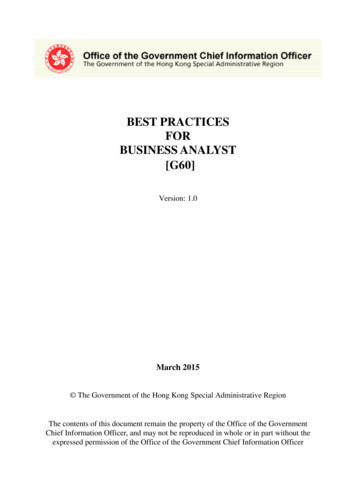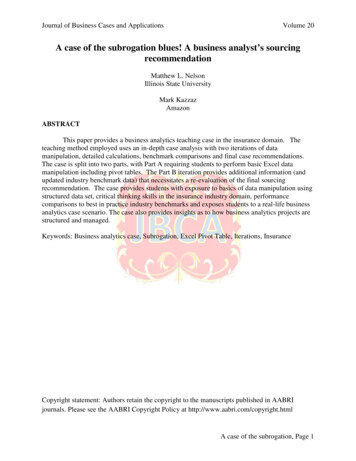
Transcription
BEST PRACTICESFORBUSINESS ANALYST[G60]Version: 1.0March 2015 The Government of the Hong Kong Special Administrative RegionThe contents of this document remain the property of the Office of the GovernmentChief Information Officer, and may not be reproduced in whole or in part without theexpressed permission of the Office of the Government Chief Information Officer
COPYRIGHT NOTICE 2015 by the Government of the Hong Kong Special Administrative RegionUnless otherwise indicated, the copyright in the works contained in this publication is owned bythe Government of the Hong Kong Special Administrative Region. You may generally copy anddistribute these materials in any format or medium provided the following conditions are met –(a) the particular item has not been specifically indicated to be excluded and is therefore not tobe copied or distributed;(b) the copying is not done for the purpose of creating copies for sale;(c) the materials must be reproduced accurately and must not be used in a misleading context;and(d) the copies shall be accompanied by the words “copied/distributed with the permission of theGovernment of the Hong Kong Special Administrative Region. All rights reserved.”If you wish to make copies for purposes other than that permitted above, you should seekpermission by contacting the Office of the Government Chief Information Officer
Best Practices for Business AnalystTable of ContentsCONVENTIONS . 1PREFACE . 2ABOUT THIS DOCUMENT . 31INTRODUCTION . 41.11.21.31.42ROLE OF BA IN IT PROJECT DELIVERY . 62.13Project Organisation with Dedicated BA . 6INVOLVEMENT OF BA IN SYSTEM DEVELOPMENT . 113.13.23.33.43.53.63.74What is Business Analysis . 4What is Business Analyst . 4Importance of and Need for a BA Role. 4Benefits of Having Dedicated BA. 5Overview . 11Business Analysis Planning . 12Business Case Definition . 17Requirements Definition . 21Assess Proposed System Option & Organisation Readiness for System Implementation . 29System Implementation and Acceptance . 32System Evaluation. 35PREPARATION FOR ESTABLISHING BA ROLES. 364.14.24.3Resources Planning . 36Required Competencies of BA . 36Other Considerations. 37GLOSSARY . 39
Best Practices for Business AnalystCONVENTIONSTable 1 - List of Acronyms used throughout the Best Practices for Business AnalystAbbreviationFull NameBABusiness AnalystBACBusiness Assurance CoordinatorFSFeasibility StudyInternal PMInternal Project ManagerITInformation TechnologyOOMObject Oriented MethodologyPATProject Assurance TeamPGPMPractice Guide to Project Management for IT Projects under anOutsourced EnvironmentPIDRPost Implementation Departmental ReturnPMPProject Management PlanPSCProject Steering CommitteeRADRapid Application DevelopmentSASystems AnalystSA&DSystems Analysis & DesignSDLCSystem Development Life CycleTACTechnical Assurance CoordinatorUACUser Assurance CoordinatorUATUser Acceptance TestUCUse CaseURDUser Requirements DocumentWBSWork Breakdown Structure1
Best Practices for Business AnalystPREFACE(a)Over the years, the Government has made great strides in harnessing informationtechnology (IT) in the delivery of public services. To enable the more efficient andeffective delivery of IT projects, it is a good practice that a business analyst (BA) role beexplicitly instituted into the IT project organisation.(b)The purpose of this “Best Practices for Business Analyst” (“Document”) is to provideguidance to government bureaux and departments (B/Ds) in instituting the role ofbusiness analyst and in conducting business analysis for IT system development projects,either outsourced or undertaken by in-house resources. For the purpose of this document,IT system development also covers IT system enhancement.(c)This Document is developed with reference to those business analysis best practices andtrends in the industry, globally and locally, and practices which are implemented in someB/Ds. This Document should be suitably adopted by B/Ds to meet their own project needs.It is not a procedure manual and the BA should apply business knowledge and experiencewhile practising business analysis to achieve the expected outcome.(d)To boost the adoption of the practices in this Document, support and buy-in of seniormanagement and business users in B/Ds are very important. It is recommended that B/Dsplan and provision for establishing and sustaining the BA role in order to enable moreefficient and effective delivery of IT projects.(e)For the purpose of this Document, the terminologies used have been customised to suit theGovernment environment.2
Best Practices for Business AnalystABOUT THIS DOCUMENTTARGET AUDIENCEThis Document is intended for reference by staff members who are responsible for managing orconducting business analysis in IT system development projects in B/Ds. They include:i)Senior executives including project owners or business owners who have the authority toallocate resource and fund to support the establishment and sustainable undertaking of the BArole in IT projects;ii) BAs or user coordinators who perform various business analysis activities;iii) Project managers who are responsible for project management and planning;andiv) Project team members who often work jointly with BAs.STRUCTURE OF THIS DOCUMENTThis Document is organised into four sections as follows:i)SECTION 1 - INTRODUCTION provides an overview of what BA is and the potentialbenefits of instituting a BA role in IT project organisation.ii) SECTION 2 - ROLE OF BA IN IT PROJECT DELIVERY highlights the activities andtasks involving BA in different phases of the System Development Life Cycle (SDLC), andexplains the role of BA in IT project organisation.iii) SECTION 3 - INVOLVEMENT OF BA IN SYSTEM DEVELOPMENT illustrates therole of BA in various phases and processes of the SDLC.iv) SECTION 4 - PREPARATION FOR ESTABLISHING BA ROLES provides informationand considerations about establishing the BA role in B/Ds.v) APPENDICES – Templates, checklists and sample documents are given for reference.Some hints and tips based upon industry practices are provided in some sections where applicableto help improve the effectiveness in conducting business analysis for IT system developmentproject.3
Best Practices for Business Analyst1INTRODUCTION1.1WHAT IS BUSINESS ANALYSISBusiness analysis refers to the identification and analysis of business problems, needs andopportunities through participation in the SDLC to help achieve the organisation’sstrategic vision and business goals.1.2WHAT IS BUSINESS ANALYSTBA refers to any person who is responsible for performing the business analysis functionsfor IT system development projects such as analysing business needs, facilitating theelicitation of user requirements, documenting and prioritising the business requirements,verifying the major project deliverables, business reengineering opportunities andworkflow from business perspective, and facilitating effective communication betweenbusiness and IT sides.1.3IMPORTANCE OF AND NEED FOR A BA ROLE(a)During IT system development, communication gap often exists between IT staff andbusiness users due to differences in knowledge, skills, background and orientation. Usersmay not understand the IT terminology and technical solutions while IT staff may notunderstand the business terminology, functions, processes and environment, leading todifficulties in eliciting real business needs and understanding of requirements as well asaffecting the design of the proposed system. The situation becomes even morechallenging if the IT project is outsourced, where more communication and collaborationissues may arise especially when the external IT contractor is not familiar with theGovernment environment and the business processes. Therefore, a BA role is importantand needed to be instituted in the IT project organisation to improve the collaborationbetween users and IT staff throughout the SDLC.(b)At project initiation stage before the formation of a project team, BA can help exploreimprovement opportunities of current state by developing sound business cases to justifythe investment of IT project and produce a clear project scope and estimation. BA role isespecially helpful in scoping and planning of large-scale projects at project initiationstage.(c)Where the demand and resources justify, a permanent establishment of the BA role isrecommended to aid in future system maintenance, support and enhancement.4
Best Practices for Business Analyst1.4BENEFITS OF HAVING DEDICATED BABA serves as the bridge between the business users and the technical IT people. Itspresence will contribute significantly to the success of IT projects. The anticipatedbenefits of having a dedicated BA include the following:i)More able to deliver a clear project scope from a business point of view;ii) More able to develop sound business cases and more realistic estimation of resourcesand business benefits;iii) More able to make a better project scoping, planning and management in costs andschedule especially for large-scale IT projects;iv) More able to produce clear and concise requirements, which in turn, helps provideclearer and more accurate tender requirements if the IT project is outsourced;v) More able to elicit the real business needs from users, and effectively manage userexpectations and changes;vi) More able to improve the quality of design for the proposed IT system so that it isable to meet real user needs and achieve the anticipated benefits;vii) More able to ensure the quality of the system developed before passing on toend-users for review and acceptance; andviii) More competent to arrange the comprehensive and quality test on the deliveredsystems or functions and provide feedback to the technical IT people.5
Best Practices for Business Analyst2ROLE OF BA IN IT PROJECT DELIVERY2.1PROJECT ORGANISATION WITH DEDICATED BA2.1.1Current Situation(a)The current IT project organisation in the Government has not explicitly instituted a BArole. The BA role is often implicitly taken up (partly or fully) by the Systems Analysts(SAs) and/or user coordinators. Since SAs are often not recruited or assigned to theproject until the approval of project funding or, in the case of outsourced projects, awardof contracts, the BA tasks required in the early project planning phase are thus not able tobe conducted effectively.(b)If a project has cross-sectional requirements and involves many different groups of users,it is often difficult for the groups of users to agree, consolidate and prioritise a list ofrequirements without the presence and help of a dedicated BA who is assigned the formalresponsibility to perform the business analysis work.(c)With reference to some B/Ds which have a relatively higher IT project success rate, theyhave assigned a group of business users to liaise between end-users and IT staff. Theyperform the BA functions such as eliciting and gathering user requirements, identifyingkey issues from the business perspective and verifying major project deliverables beforepassing on to end-users for review. They are often nominated by the Project Owner, theProject Steering Committee (PSC) or the Project Assurance Team (PAT) of the IT projectorganisation.2.1.2BA Role in IT Project Organisation(a)B/Ds should explicitly institute a BA role in the project organisation for IT systemdevelopment projects, especially for new business areas, or business areas withcomplicated processes, requirements, or involving many different groups of stakeholdersor end-users from different divisions or B/Ds.(b)No matter the project is developed in-house or outsourced, BA is an essential role thatshould preferably be taken up by experienced business user in the B/D who is familiarwith the business environment and possesses sufficient business knowledge as well asbasic IT knowledge. Figure 1 shows the BA role in the IT project organisation.6
Best Practices for Business AnalystFigure 1 - BA role in the IT project organisation(c)B/Ds should assign sufficient staff resources to take up the BA role according to projectsize and complexity. It is recommended that at least one dedicated staff member fromuser side should be assigned to each project. The staff member(s) can either be workingfull time or part time on the project, depending on the workload in different phases of theSDLC and nature or complexity of the IT projects. The BA should be an officer fromdepartmental grade or other grades in B/Ds who are experienced and knowledgeable inbusiness processes or IT system development projects, approximately equivalent at therank of Executive Officer I or Senior Executive Officer, or Management Services OfficerI or Senior Management Services Officer, depending on the project size, scale andcomplexity.(d)A B/D may also determine whether the BA(s) should report to the Project Owner, PSC,PAT or Internal Project Manager (Internal PM) in the IT project organisation, dependingon project needs, organisation structure and project phases. For example, the BA maydirectly report to the Project Owner at project initiation phase. After project fund isapproved and the IT project team is formed, the BA may report to the PSC and workjointly with the Internal PM and IT project team. If the project is large and a BA team isestablished in the B/D, the Head of the BA team may be a member of the PSC and a seniorBA may also be a member of the PAT to help assure the quality of deliverables from thebusiness perspective. If the role of Internal PM is taken up by departmental grade staff,then the BA role may be assumed by a subordinate of the Internal PM. The B/D mayflexibly select a suitable reporting line for the BA role in its own IT project organisation.7
Best Practices for Business Analyst(e)Regardless of the reporting line, BA should have a close working relationship with theInternal PM and the IT project team throughout the SDLC. BA focuses on matters relatedto business while Internal PM and IT project team focus on project management and ITmatters. BA often needs to coordinate and discuss with, and seek assistance/input fromthe Internal PM or IT project team on project management and IT aspects, transformtechnical information into layman’s terms for users to understand, and elicit and analyseuser requirements for IT staff to design and develop the IT system.(f)A table showing the main differences in the roles and responsibilities between BA and SA,as well as between User Assurance Coordinator (UAC) and Business AssuranceCoordinator (BAC) are shown below. For details, please refer to Appendix 1.Table 2 - Differences of BA, SA, UAC and BACItemBAPositionMember of ITprojectorganisationReporting toMainResponsibility2.1.3SAMember of ITproject teamUACBACMember of PATMember of PATProject Owner,Internal PMPSC, PAT orInternal PM [referto (d) above](according toproject needs andproject phases)PSCPSCLiaise betweenend-user side andIT side, facilitatethe elicitation andanalysis ofrequirementsEnsure userrequirements areproperly specifiedEnsure thatbusiness issuesarising during theproject areproperly managedPerform systemanalysis anddesign,implementation,testing and dataconversionRoles and Responsibilities of BAThe major role of BA is to liaise between end-user side and IT side to help identify andanalyse business problems and needs, and work closely with the SA during thedevelopment of IT system to achieve the business goals. The major responsibilities of BAare listed as follows:8
Best Practices for Business Analysti)Contribute to the Development of Business CaseAssist users in identifying business problems, needs and functions, understandstakeholders’ concerns and requirements, identify improvement opportunities, andcontribute business input for developing the business case for the IT systemdevelopment project.ii) Facilitate the Elicitation and Analysis of RequirementsCollaborate and communicate with stakeholders to elicit, consolidate, analyse andprioritise requirements, manage their expectations and needs, and help ensure therequirements are complete, unambiguous and map to real business needs.iii) Assess Proposed System Option and Organisation Readiness for SystemImplementationProvide support to users and coordinate with IT staff to help review and provide inputto the design of the IT system from the business perspective, resolve issues/conflictsamong stakeholders, help organise comprehensive and quality UAT through assistingusers in developing test cases, and help organise training with the aim of ensuring thedeployed IT system is capable of meeting business needs and requirements as well asrealising the anticipated benefits.iv) Plan and Monitor the Business Analysis ActivitiesPlan the scope, schedule and approach for performing the activities related to businessanalysis for the IT system development project, monitor the progress, coordinate withthe Internal PM and report to PAT or PSC on changes, risks and issues whereverappropriate.2.1.4Hints and TipsTable 3 - Tips for BA Role in IT Project Organisation(a)Relationship between BA and project manageri) Project managers should understand that BAs need to be involved in all phases of theSDLC including elicitation and documentation of requirements. On the other hand, BAsshould keep the project managers aware of issues such as changes in requirements orsystem functions and the corresponding impacts.ii) Both BA and project manager should understand each other’s roles and responsibilities inthe project organisation, and closely communicate and coordinate with each other.9
Best Practices for Business AnalystSubject to the organisation structure and practical considerations such as those mentionedin 2.1.2(d), in general a peer-to-peer relationship is preferred to subordinate-to-supervisorrelationship between the BA and the project manager. This helps to facilitate the liaisonbetween the user side and the IT side and more easily establish mutual understandingbetween the BA and the project manager. A strong partnership between the BA
business analyst and in conducting business analysis for IT system development projects, either outsourced or undertaken by in-house resources. For the purpose of this document, IT system development also covers IT system enhancement. (c) This Document is developed wit











